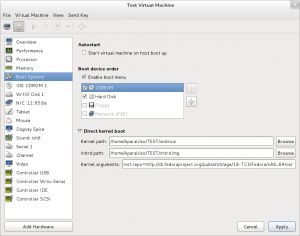From Fedora Project Wiki
(some more revision and clarification) |
(update sample config and log output) |
||
| (9 intermediate revisions by 3 users not shown) | |||
| Line 1: | Line 1: | ||
{{Template:Associated_release_criterion|Beta|direct-kernel-boot}} | |||
{{QA/Test_Case | {{QA/Test_Case | ||
|description=This | |description=This is to verify that it is possible to boot [[Anaconda]] and install the system by direct kernel+initrd boot. That can be achieved either by using [http://en.wikipedia.org/wiki/Preboot_Execution_Environment PXE boot] or by booting the kernel directly in a virtual machine. | ||
|setup= | |||
| | <ol> | ||
<li>You will need {{filename|vmlinuz}} and {{filename|initrd.img}} files. Those are located in the {{filename|(arch)/os/images/pxeboot}} directory of the tree for the Fedora compose you wish to test.</li> | |||
<li>You will need a remote location containing Anaconda's {{filename|LiveOS/}} directory (containing the installer) and optionally also a package repository. Development composes are usually available at [http://dl.fedoraproject.org/pub/alt/stage/ dl.fedoraproject.org/pub/alt/stage/] (doesn't contain package repository). If you have a local mirror, you can make it accessible over any protocol supported by [[Anaconda_Boot_Options#repo|inst.repo]] boot option.</li> | |||
<li>''Option 1:'' Set up a PXE server. | |||
<ul> | |||
<li>This is not an easy task and requires some administrator knowledge. You can read the [https://docs.fedoraproject.org/en-US/fedora/f{{FedoraVersionNumber}}/install-guide/advanced/Network_based_Installations/ appropriate section in the Installation guide for Fedora {{FedoraVersionNumber}}].</li> | |||
<li>The custom pxelinux config file can look like this: | |||
{{#tag:pre|default vesamenu.c32 | |||
prompt 1 | |||
timeout 600 | |||
label linux | |||
menu label ^Install Fedora | |||
menu default | |||
kernel fedora/vmlinuz | |||
append initrd=fedora/initrd.img inst.repo=https://dl.fedoraproject.org/pub/alt/stage/{{FedoraVersionNumber|next}}_Beta-1.1/Server/x86_64/os/}}</li> | |||
</ul> | |||
</li> | |||
<li>''Option 2:'' Boot kernel directly in a virtual machine. | |||
<ul> | |||
<li>Prepare a virtual machine that can boot kernel+initrd pair directly, e.g. using {{package|virt-manager}} (virt-manager has a ''Direct kernel boot'' field where you can specify the kernel, initrd and any boot options).<br/> | |||
[[image:virt-manager-pxeboot.png|300px]]</li> | |||
</ul> | |||
</li> | |||
</ol> | |||
|actions= | |actions= | ||
# Boot the | # Boot the system via PXE, or using a virtual machine with appropriate [[Anaconda_Boot_Options#repo|inst.repo]] boot argument (it has to point to the same compose you used for retrieving {{filename|vmlinuz}} and {{filename|initrd.img}}). | ||
# Proceed with installation. | |||
|results= | |results= | ||
<ol> | |||
# | <li>The system boots (using PXE or direct kernel boot in a virtual machine) and it downloads anaconda installer from the specified remote location.</li> | ||
<li>The installer starts correctly.</li> | |||
<li>If the remote location contains a DNF repository, that repository is used for installation. This can be checked by examining the {{filename|/tmp/packaging.log}} file. Example output: | |||
{{#tag:pre| | |||
09:35:25,625 INF packaging: added repo: 'anaconda' - https://dl.fedoraproject.org/pub/alt/stage/31_Beta-1.1/Server/x86_64/os | |||
09:35:25,647 DBG dnf: repo: downloading from remote: anaconda | |||
09:35:27,161 INF packaging: enabled repo: '' - ['https://dl.fedoraproject.org/pub/alt/stage/31_Beta-1.1/Server/x86_64/os'] and got repomd | |||
09:35:27,163 DBG dnf: repo: using cache for: anaconda | |||
09:35:27,163 DBG packaging: repo anaconda: _sync_metadata success from ['https://dl.fedoraproject.org/pub/alt/stage/31_Beta-1.1/Server/x86_64/os'] | |||
09:35:27,165 DBG dnf: repo: using cache for: anaconda | |||
05:35:50,985 DBG dnf: anaconda: using metadata from Tue 20 Aug 2019 02:34:29 AM EDT. | |||
}}</li> | |||
<li>The installation completes and the new system initiates boot properly</li> | |||
</ol> | |||
}} | }} | ||
[[Category:Installer Boot Methods]] | [[Category:Installer Boot Methods]] | ||
[[Category:Package_anaconda_test_cases]] | [[Category:Package_anaconda_test_cases]] | ||
Latest revision as of 17:37, 20 August 2019
Description
This is to verify that it is possible to boot Anaconda and install the system by direct kernel+initrd boot. That can be achieved either by using PXE boot or by booting the kernel directly in a virtual machine.
Setup
- You will need
vmlinuzandinitrd.imgfiles. Those are located in the(arch)/os/images/pxebootdirectory of the tree for the Fedora compose you wish to test. - You will need a remote location containing Anaconda's
LiveOS/directory (containing the installer) and optionally also a package repository. Development composes are usually available at dl.fedoraproject.org/pub/alt/stage/ (doesn't contain package repository). If you have a local mirror, you can make it accessible over any protocol supported by inst.repo boot option. - Option 1: Set up a PXE server.
- This is not an easy task and requires some administrator knowledge. You can read the appropriate section in the Installation guide for Fedora 41.
- The custom pxelinux config file can look like this:
default vesamenu.c32 prompt 1 timeout 600 label linux menu label ^Install Fedora menu default kernel fedora/vmlinuz append initrd=fedora/initrd.img inst.repo=https://dl.fedoraproject.org/pub/alt/stage/42_Beta-1.1/Server/x86_64/os/
- Option 2: Boot kernel directly in a virtual machine.
- Prepare a virtual machine that can boot kernel+initrd pair directly, e.g. using
 virt-manager
virt-manager

- Prepare a virtual machine that can boot kernel+initrd pair directly, e.g. using
How to test
- Boot the system via PXE, or using a virtual machine with appropriate inst.repo boot argument (it has to point to the same compose you used for retrieving
vmlinuzandinitrd.img). - Proceed with installation.
Expected Results
- The system boots (using PXE or direct kernel boot in a virtual machine) and it downloads anaconda installer from the specified remote location.
- The installer starts correctly.
- If the remote location contains a DNF repository, that repository is used for installation. This can be checked by examining the
/tmp/packaging.logfile. Example output:09:35:25,625 INF packaging: added repo: 'anaconda' - https://dl.fedoraproject.org/pub/alt/stage/31_Beta-1.1/Server/x86_64/os 09:35:25,647 DBG dnf: repo: downloading from remote: anaconda 09:35:27,161 INF packaging: enabled repo: '' - ['https://dl.fedoraproject.org/pub/alt/stage/31_Beta-1.1/Server/x86_64/os'] and got repomd 09:35:27,163 DBG dnf: repo: using cache for: anaconda 09:35:27,163 DBG packaging: repo anaconda: _sync_metadata success from ['https://dl.fedoraproject.org/pub/alt/stage/31_Beta-1.1/Server/x86_64/os'] 09:35:27,165 DBG dnf: repo: using cache for: anaconda 05:35:50,985 DBG dnf: anaconda: using metadata from Tue 20 Aug 2019 02:34:29 AM EDT.
- The installation completes and the new system initiates boot properly
